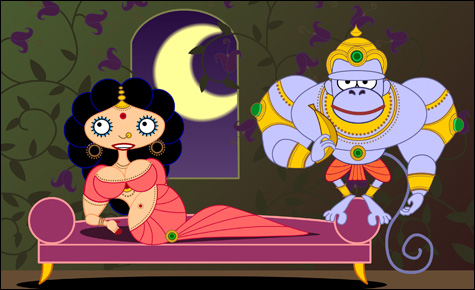
SITA SINGS THE BLUES Ignore the nay-sayers — it's utterly charming. |
With Up soaring at the box office, it's clear that the Pixar zeppelin won't be crashing anytime soon. It's a credit to Pixar's success that so many animated films of the past decade have been compelled to sport the sheen of CGI. But now that filmmakers have wrung reality out of 1's and 0's, they're starting to cast their eyes on the next frontier: computer-aided animation done in novel, distinctive artistic styles. We've seen it in Sin City and 300, which re-created the moody comic-book panels of Frank Miller. And this weekend, June 12-14, you can see two more hyperstylized digital beauties screening back-to-back at the Brattle: Sita Sings the Blues (2008; 82 minutes) and Azur & Asmar: The Princes' Quest (2006; 99 minutes).
Billed as "The Greatest Break-Up Story Ever Told," Nina Paley's Sita Sings the Blues is a musical journey through the ancient Sanskrit text the Ramayana rendered in sleek Flash vector graphics, cut-paper collage, and rotoscoping. Paley mashes up the songs of '20s jazz singer Annette Hanshaw with the tragic life of the abducted Sita, who spends her days pining for her beloved Rama; this is juxtaposed with autobiographical snippets from Paley's own divorce. (Her husband went to India and sent her a "Dear Nina" e-mail.) As Hanshaw's coquettish man-done-me-wrong ditties narrate our heroine's plight, the voluptuous and wide-eyed Sita turns out to be a Bollywood Betty Boop, swinging to the beat with high-stepping gods, one-eyed demons, and grinning celestial bodies. The film is utterly charming, its energy magnetic.

Not everyone, however, is smitten with Sita. Paley's casual, cutesy cannibalization of Hindu mythology has pissed off many viewers. Then there's the copyright issue regarding Hanshaw's songs. Rather than change the soundtrack, Paley released the film under a Creative Commons license — the upshot being that you can download it for free.
On a grander scale is Azur & Asmar, the brainchild of French animator Michel Ocelot, who's been racking up plaudits all over Europe since the '70s. Set in a misty medieval-esque time, the film tells the story of Azur, a lily-white boy raised by his Arab nanny alongside her own son, Asmar. The nanny fills her boys' heads with fantastical tales of the djinn fairy. Obsessed with marrying the fairy, Azur and Asmar journey to find her, scaling a heap of obstacles (a man-eating Scarlet Lion, a door of gnashing swords, various thugs) first as rivals, then as brothers.
Azur & Asmar is nothing if not visually exquisite. Ocelot combines 2-D painted scenery and CGI characters to produce an effect that's like watching a Maxfield Parrish poster come to life: crisp, delicate, luminous. His script, on the other hand, uses a sledgehammer to pound out deafening morals about xenophobia and prejudice, his maddeningly slow plot serving partly as an allegory for the thorny relationship between France and Algeria.
The lavishly rendered minarets and mosques of Azur & Asmar evoke another ambitious Middle Eastern–inspired indie animation project: The Thief and the Cobbler. Richard Williams (of Who Framed Roger Rabbit? fame) spent 26 years making an avant-garde Arabian Nights–flavored masterpiece, only to have Miramax swoop in and butcher it. The Thief and the Cobbler Ocelot's film is not — compared with Williams's kinetic artistic vision, it's hopelessly flat — but the fact that a unique animated indie film can be finished in three years instead of ruined in three decades bodes well for animation's future.